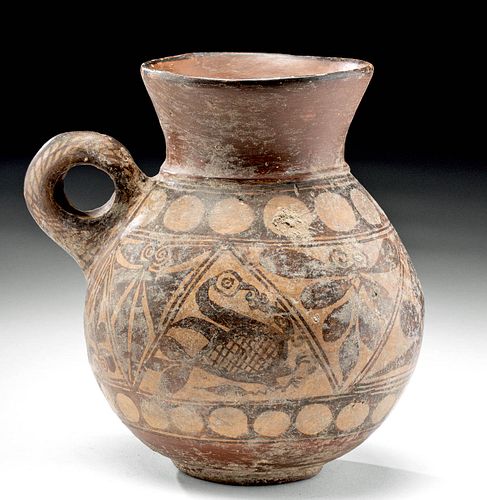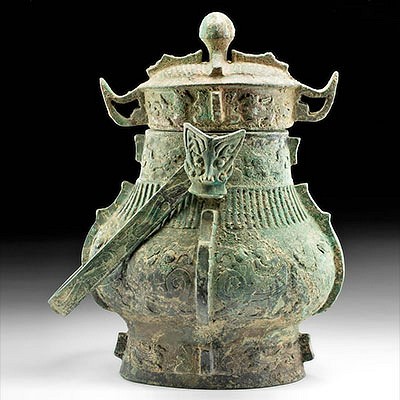Afghanistan Ghurid Jam Pottery Pitcher
Lot 67
About Seller
Artemis Fine Arts
686 S Taylor Ave, Ste 106
Louisville, CO 80027
United States
Selling antiquities, ancient and ethnographic art online since 1993, Artemis Gallery specializes in Classical Antiquities (Egyptian, Greek, Roman, Near Eastern), Asian, Pre-Columbian, African / Tribal / Oceanographic art. Our extensive inventory includes pottery, stone, metal, wood, glass and textil...Read more
Categories
Estimate:
$2,000 - $3,000
Absentee vs Live bid
Two ways to bid:
- Leave a max absentee bid and the platform will bid on your behalf up to your maximum bid during the live auction.
- Bid live during the auction and your bids will be submitted real-time to the auctioneer.
Bid Increments
| Price | Bid Increment |
|---|---|
| $0 | $25 |
| $300 | $50 |
| $1,000 | $100 |
| $2,000 | $250 |
| $5,000 | $500 |
| $10,000 | $1,000 |
| $20,000 | $2,500 |
| $50,000 | $5,000 |
| $100,000 | $10,000 |
| $200,000 | $20,000 |
About Auction
By Artemis Fine Arts
Jul 1, 2020
Set Reminder
2020-07-01 10:00:00
2020-07-01 10:00:00
America/New_York
Bidsquare
Bidsquare : Ancient | Near-Eastern | Asian Art
https://www.bidsquare.com/auctions/artemis-gallery/ancient-near-eastern-asian-art-5276
Ancient art from Egypt, Greece, Italy and the Near East, as well as Asian, Fossils, Pre-Columbian, Native American, African / Tribal / Oceanic, Spanish Colonial, Russian Icons, Fine art, much more! Artemis Fine Arts info@artemisgallery.com
Ancient art from Egypt, Greece, Italy and the Near East, as well as Asian, Fossils, Pre-Columbian, Native American, African / Tribal / Oceanic, Spanish Colonial, Russian Icons, Fine art, much more! Artemis Fine Arts info@artemisgallery.com
- Lot Description
Central Asia, central Afghanistan, Jam in Ghur province, Ghurid Dynasty, ca. 12th to 13th century CE. An ornate ceramic vessel from a little known culture. It features a wide, near-spherical body with a narrow disc foot, a tapering shoulder, and a corseted neck that rapidly widens to a broad lip. A cute loop handle sits on the upper body. The entire exterior surface of the vessel from just above the foot is covered in a profusion of black, red, and cream-colored decoration, including geometric motifs and birds. Size: 5.25" W x 5.45" H (13.3 cm x 13.8 cm)
Afghanistan has had little modern archaeological research and as a result its history remains sadly unexplored - for example, most of the knowledge about the country's medieval ceramics is from the 1950s and 1960s. However, the country clearly has a rich heritage. The area today known as Jam was once Firuzkuh, the summer capital of the Ghurid sultanate, destroyed by the Mongols around 1222-1223 CE and rediscovered by international researchers because of its huge minaret in 1957. A wide profusion of different style vessels seem to have been made in medieval Jam during the short Ghurid Dynasty, which enjoyed brief success in the 12th century before collapsing after the death of its most charismatic rulers; indeed, when the Mongols destroyed it, it seems to have already been a city in decline. The pottery made there is all the more remarkable for the brief window in which it was made. This example, clearly inspired by contemporary Iranian ceramics, demonstrates the cosmopolitan nature of medieval Afghanistan.
Provenance: private California, USA collection, by descent, moved from Germany in 1997, originally collected in the 1970s in Hamburg, Germany
All items legal to buy/sell under U.S. Statute covering cultural patrimony Code 2600, CHAPTER 14, and are guaranteed to be as described or your money back.
A Certificate of Authenticity will accompany all winning bids.
We ship worldwide and handle all shipping in-house for your convenience.
#155971Intact, with light wear on surface commensurate with age. Really nice deposits and root marks with well preserved motifs.Condition
- Shipping Info
-
All shipping is handled in-house for your convenience. Your invoice from Artemis Gallery will include shipping calculation instructions. If in doubt, please inquire BEFORE bidding for estimated shipping costs for individual items.
-
- Buyer's Premium



 EUR
EUR CAD
CAD AUD
AUD GBP
GBP MXN
MXN HKD
HKD CNY
CNY MYR
MYR SEK
SEK SGD
SGD CHF
CHF THB
THB
















